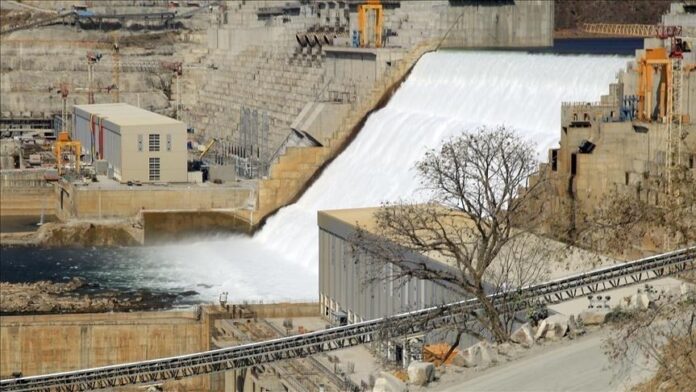Cairo / Anadolu Agency –
Egypt’s Ministry of Water Resources and Irrigation said in a statement that Ethiopia’s actions “leave no doubt about the falsity of its repeated claims of causing no harm to others” in operating the Grand Ethiopian Renaissance Dam (GERD).
No response from the Ethiopian side had been issued as of 18:30 GMT.
Cairo on Friday accused Addis Ababa of “reckless and irresponsible” behavior in managing the GERD, saying such actions have harmed Sudan and pose a direct threat to Egyptian land and lives.
The ministry’s statement, referring to “the Nile flooding and Ethiopia’s unilateral operation of the dam in violation of international law,” came amid deadly floods that recently struck parts of Sudan and inundated lands along the Nile and its tributaries in Egypt.
The ministry said it has been monitoring the developments of this year’s Nile flood “and the associated unilateral and reckless actions taken by Ethiopia in managing its illegal dam in violation of international law.” It said such actions “lack even the most basic norms of responsibility and transparency and represent a direct threat to the lives and security of downstream nations.”
These actions, the statement continued, “also expose beyond any doubt the falsity of Ethiopia’s repeated claims that GERD operations cause no harm. They reveal, instead, a political exploitation of the river’s waters at the expense of lives and regional stability.”
The ministry explained that the Nile River originates from three main tributaries: the White Nile (which flows from Lake Victoria on the borders of Uganda, Tanzania, and Kenya), and the Blue Nile and Atbara rivers (both originating in Ethiopia). It added that this year’s overall Nile flood levels from the three sources are about 25 percent higher than average.
Technically, the ministry said, Ethiopia should have begun gradually storing water in the GERD between early July and late October — the normal flood season — and then releasing it in a controlled manner for power generation throughout the year, in line with Ethiopia’s repeated claims that the dam helps regulate flooding, protect Sudan from inundation, and provide electricity to the Ethiopian people.
“However,” it continued, “by late August 2025, it was observed that GERD operators had violated recognized technical and scientific norms by storing more floodwater than expected while reducing outflows from about 280 million cubic meters to just 110 million cubic meters on September 8, 2025.”
According to the ministry, these actions “reflect Ethiopia’s hasty drive to complete filling the reservoir to the 640-meter level above sea level, after which it briefly opened the central and emergency spillways purely for media publicity during what it called the dam’s inauguration ceremony on September 9, 2025 — with no regard for water safety or the interests of downstream nations.”
It affirmed that this was confirmed by subsequent events: immediately after the so-called inauguration, on September 10, the Ethiopian operators released about 485 million cubic meters of water in a single day, followed by sudden and unexplained increases in discharge reaching 780 million cubic meters on September 27 before dropping to 380 million cubic meters on September 30.
Estimates, the ministry said, show that the dam’s water level fell by nearly one meter, equivalent to an unaccounted discharge of around two billion cubic meters of stored water — in addition to the natural flood flow — exacerbating the scale of released water and exposing “the dam’s chaotic and unsafe operation.”
The statement further asserted that “Ethiopia’s unilateral and irresponsible management of the dam altered the natural flood cycle, whose peak normally occurs in August, and created an artificial flood of greater severity later in September.”
The ministry rejected media and social media claims that Egyptian “governorates” were flooded, calling them “false and misleading.” It clarified that floodwaters only reached riverbank lands known as Tir‘at al-Nahr (Nile’s margin lands), which form naturally through silt and deposition during the river’s flood cycles. These areas, it noted, “are part of the Nile’s natural domain and prone to submersion when water levels rise — not governorates as wrongly claimed.”
The ministry concluded its statement by affirming that “the Egyptian state, through all its agencies, continues to monitor the situation around the clock.”
On Wednesday, Egyptian Foreign Minister Badr Abdel Aaty said in Port Sudan, ahead of his meeting with Sudan’s Sovereign Council chairman, that “the lack of coordination in operating the dam has led to devastating floods in Sudan in recent weeks,” emphasizing that “Ethiopia’s unilateral moves regarding the GERD constitute a violation of international law.”
The dispute continues between Egypt and Sudan on one side and Ethiopia on the other over the filling and operation of the Grand Ethiopian Renaissance Dam, whose construction began in 2011. Cairo and Khartoum insist on reaching a legally binding tripartite agreement before any further action, while Addis Ababa maintains that no such agreement is necessary and that the dam will not harm the interests of any other nation.
Talks were suspended for three years before resuming in 2023, only to be frozen again in 2024.


